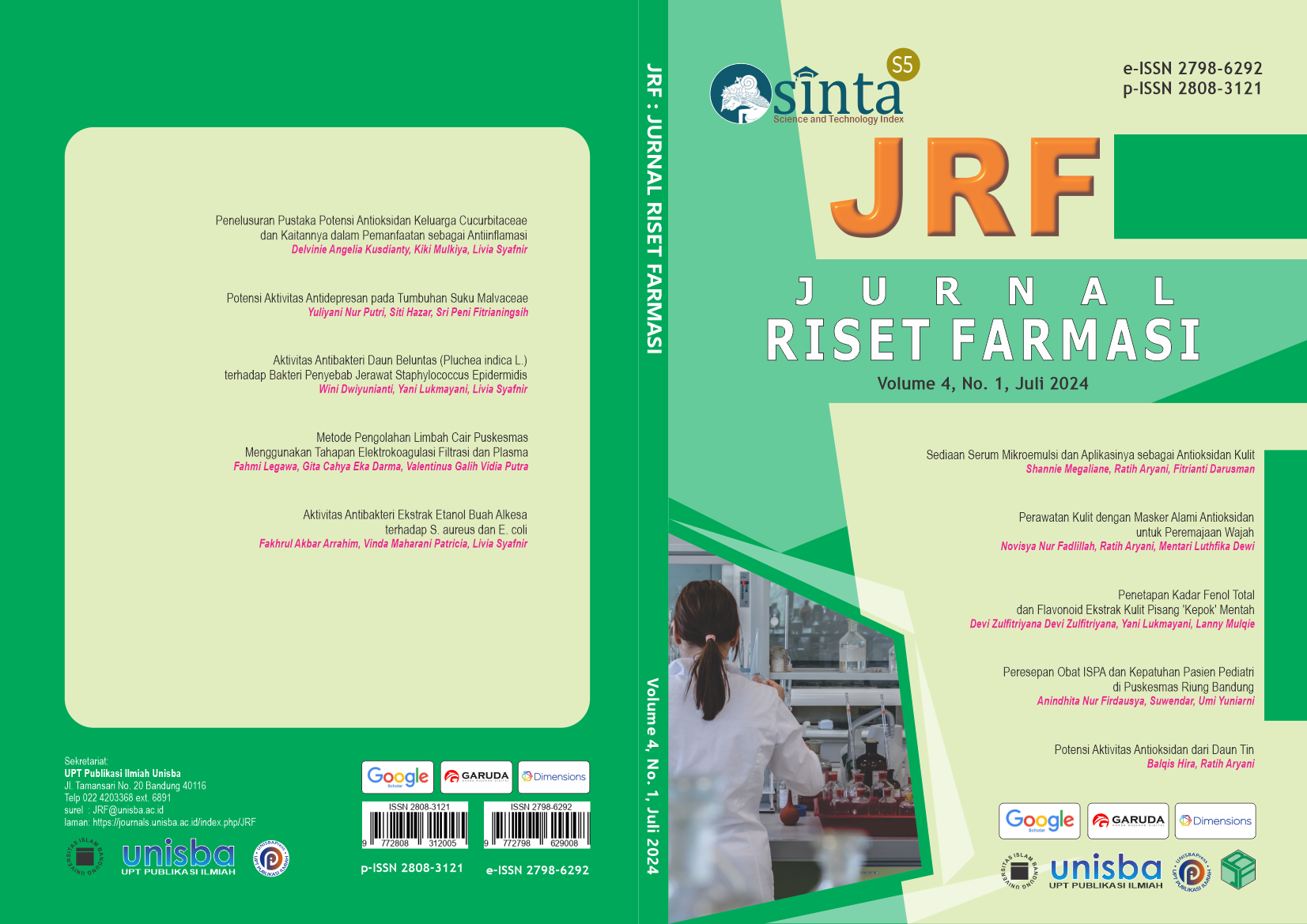Aktivitas Antibakteri Ekstrak Etanol Buah Alkesa terhadap S. aureus dan E. coli
DOI:
https://doi.org/10.29313/jrf.v4i1.3891Keywords:
Fruit alkes, Antibacterial, Staphylococcus aureusAbstract
Abstract. Alkesa fruit (Pouteria campechiana (Kunth) Baehni) has many benefits, one of which is suspected to possess pharmacological activity as an antibacterial agent. Staphylococcus aureus and Escherichia coli are pathogenic bacteria that commonly cause diseases in humans, such as diarrhea. The aims of this study was to determine the antibacterial activity of the ethanol extract of alkesa fruit against Staphylococcus aureus and Escherichia coli, as well as to determine the Minimum Inhibitory Concentration (MIC). The antibacterial activity test was conducted using the agar diffusion method with ethanol extract of alkesa fruit at concentrations ranging from 35% to 100% (w/v). The results showed that the ethanol extract of alkesa fruit exhibited the same level of activity against both bacteria, with the same minimum inhibitory concentration, which is 36%.
Abstrak. Buah alkesa (Pouteria campechiana (Kunth) Baehni) memiliki banyak manfaat yang salah satunya diduga memiliki aktivitas farmakologi sebagai antibakteri. Bakteri Staphylococcus aureus dan Escherichia coli merupakan bakteri patogen yang biasanya menimbulkan penyakit pada manusia contohnya yaitu penyakit diare. Tujuan penelitian ini untuk mengetahui aktivitas antibakteri ekstrak etanol buah alkesa terhadap Staphylococcus aureus dan Escherichia coli serta menentukan Konsentrasi Hambat Minimum. Pengujian aktivitas antibakteri dilakukan dengan metode difusi agar sumuran menggunakan ekstrak etanol buah alkesa dengan rentang konsentrasi 35% - 100% (b/v). Hasil pengujian menunjukkan bahwa ekstrak etanol buah alkesa memiliki aktivitas yang sama terhadap kedua bakteri dengan konsentrasi hambat minimum yang sama yaitu 36%.
References
L. Zulkil Amin, “CONTINUING MEDICAL EDUCATION Tatalaksana Diare Akut,” Contin. Med. Educ. , vol. 42, no. 7, p. 2015, 2015.
World gastroentorology Organisation, “Acute diarrhea in adults and children: A global perspective. World Gastroenterology Organisation Global Guidelines,” J Clin Gastroenterol, vol. 47, no. 1, pp. 12–20, 2012.
WHO, “Diarrhoea.” 2022. [Online]. Available: https://www.who.int/health-topics/diarrhoea#tab=tab_1
Kementerian Kesehatan RI, Laporan Riset Kesehatan Dasar (Riskesdas) 2018. 2018.
H. A. P. Hanifah Arini Putri and Dina Mulyanti, “Karakterisasi Simplisia dan Ekstrak Etanol Daun Pegagan (Centella asiatica (L.) Urban),” J. Ris. Farm., pp. 43–48, 2023, doi: 10.29313/jrf.v3i1.3120.
N. Muliawati, U. Yuniarni, and R. Choesrina, “Uji Aktivitas Antioksidan Ekstrak Etanol Daging Buah Sawo Walanda Pouteria campechiana ( Kunth ) Baehni dengan Metode DPPH,” Pros. Farm., vol. 2, no. 2, pp. 844–850, 2016.
Muhammad Nur Fauzi, Joko Santoso, and Aldi Budi Riyanta, “Uji Kualitatif dan Uji Aktivitas Antioksidan Ekstrak Etanolik Buah Maja (Aegle Marmelos (L.)Correa) dengan Metode DPPH,” J. Ris. Farm., vol. 1, no. 1, pp. 1–8, Jul. 2021, doi: 10.29313/jrf.v1i1.25.
K. H. Pradita, U. Yuniarni, and R. Choesrina, “Uji Aktivitas Antibakteri dari Ekstrak Etanol Daun Sawo Walanda ( Pouteria Campheciana ( Kunth ) Baehni ) terhadap Escherichia coli,” Pros. Farm., vol. 2, no. 2, pp. 670–674, 2016.
T. Rudiana, D. D. Indiatmoko, and D. Rohim, “Aktivitas Antioksidan dan Profil Senyawa Metabolit Sekunder Ekstrak Kulit Batang Alkesa (Pouteria campechiana),” Chim. Nat. Acta, vol. 10, no. 2, pp. 66–71, 2022.
M. E. Aly, D. E. T. Nebal, F. M. Sherifa, M. A. Rabab, and A. W. E. A. Sally, “Chemical composition and biological activities of Pouteria campechiana (Kunth) Baehni,” J. Med. Plants Res., vol. 10, no. 16, pp. 209–215, 2016, doi: 10.5897/jmpr2015.6031.
M. I. Abdurrozak, L. Syafnir, and E. R. Sadiyah, “Uji Efektivitas Ekstrak Etanol Daun Angsana (Pterocarpus Indicus Willd) sebagai Biolarvasida terhadap Larva Nyamuk Culex Sp.,” J. Ris. Farm., vol. 1, no. 1, pp. 33–37, Jul. 2021, doi: 10.29313/jrf.v1i1.45.
Annisa Yunia Rachmatika and Suwendar, “Uji Sitotoksik Ekstrak Etanol Kulit Batang Awar-awar dengan Metode BSLT,” J. Ris. Farm., pp. 103–108, 2023, doi: 10.29313/jrf.v3i2.3161.
F. Awang-Kanak and M. F. A. Bakar, Canistel—Pouteria campechiana (Kunth) Baehni. In Exotic Fruits. 2018.
Winangsih, E. Prihastanti, and S. Parman, “PENGARUH METODE PENGERINGAN TERHADAP KUALITAS SIMPLISIA LEMPUYANG WANGI (Zingiber aromaticum L.),” Bul. Anat. dan Fisiol., vol. 3, no. April, pp. 19–25, 2015.
D. P. RI., “Farmakope Indonesia (Edisi IV),” 1995.
L. S. Nurhayati, N. Yahdiyani, and A. Hidayatulloh, “Perbandingan Pengujian Aktivitas Antibakteri Starter Yogurt dengan Metode Difusi Sumuran dan Metode Difusi Cakram,” J. Teknol. Has. Peternak., vol. 1, no. 2, p. 41, 2020, doi: 10.24198/jthp.v1i2.27537.
E. Apriliana, A. Tjiptaningrum, and R. Julianingrum, “Perbandingan Efektivitas Ekstrak Propolis Dalam Menghambat Pertumbuhan Pertumbuhan Bakteri Gram Positif (Staphylococcus aureus) danGram Negatif (Escherichia coli) Secara In Vitro,” J. Kedokt. Univ. Lampung, vol. 3, no. 1, pp. 129–134, 2019.
D. Afriza, I. Effendi, and Y. Siregar, “Isolation, Identification and Antagonism Test of Heterotrohic Bacteria in Mangrove Plants Againts Pathogenic Bacteria (Vibrio alginolyticus, Aeromonas hydrophila, and Pseudomonas sp.),” J. Perikan. Dan Kelaut., vol. 24, no. 1, pp. 61–68, 2019.
R. Maksum, Buku Ajar Mikrobiologi Panduan Mahasiswa Farmasi dan Kedokteran. Jakarta: Kedokteran EGC, 2010.
J. M.Willey, L. M.Sherwood, and C. J.Woolverton, “Prescott, Harley, and Klein’s Microbiology,” pp. 1–1426, 2014.












